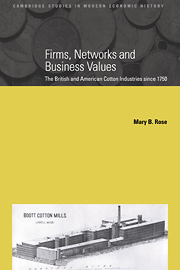Book contents
- Frontmatter
- Contents
- List of figures
- List of tables
- Acknowledgements
- 1 Introduction: the evolution of two industries
- Part I The culture of business networks 1750–1860
- Part II Continuity and change
- 6 Consolidation and change, 1860–1914
- 7 Prosperity and decay in war and peace, 1914–39
- 8 The turbulent years, 1939–80: the politics of decline
- 9 Conclusion
- References
- Index
- Cambridge Studies in Modern Economic History
7 - Prosperity and decay in war and peace, 1914–39
Published online by Cambridge University Press: 12 September 2009
- Frontmatter
- Contents
- List of figures
- List of tables
- Acknowledgements
- 1 Introduction: the evolution of two industries
- Part I The culture of business networks 1750–1860
- Part II Continuity and change
- 6 Consolidation and change, 1860–1914
- 7 Prosperity and decay in war and peace, 1914–39
- 8 The turbulent years, 1939–80: the politics of decline
- 9 Conclusion
- References
- Index
- Cambridge Studies in Modern Economic History
Summary
Despite the dramatic expansion of United States cotton manufacturing in the late nineteenth century, Lancashire remained the home of the world's largest cotton industry before the First World War. Yet, during the war and afterwards the increased capacity and continued labour productivity growth in the United States meant that by 1924, the United States had overtaken Britain as the largest producer of cotton cloth (see Table 7.1). During the 1920s and more especially the 1930s, on the other hand, both industries encountered the increasing competitive threat of Japan at home and abroad. The Japanese share of world cotton textile exports outstripped Britain by 1933, a lead which she sustained throughout the 1930s, as Figures 7.1 and 7.2 demonstrate.
By the outbreak of the First World War, despite common technological origins, the British and American cotton industries had developed along quite different trajectories. Distinctiveness in the experience of industrialisation, in government–industry relations, in commercial policy and in the characteristics of product and factor markets meant that the historical forces shaping business strategy were strikingly dissimilar. The sharpest contrast came in the product and market orientation of the two nations, with Britain having the world's most export-oriented cotton industry. On the other hand, efforts to penetrate the Far Eastern market had only marginally reduced the legendary reliance of the United States cotton industry on its domestic market. The divergent evolution of the two industries and the resultant contrasts in organisation and capabilities make the shared experience of difficulties and decay in the interwar period all the more remarkable – their explanation is one of the principal themes of this chapter.
- Type
- Chapter
- Information
- Firms, Networks and Business ValuesThe British and American Cotton Industries since 1750, pp. 198 - 249Publisher: Cambridge University PressPrint publication year: 2000



